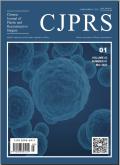Technical refinement of the reverse homodigital dorsoradial flap: A preliminary case report on flap optimization for radial thumb defects
Chinese Journal of Plastic and Reconstructive Surgery
Pub Date : 2025-09-01
DOI:10.1016/j.cjprs.2025.08.002
引用次数: 0
Abstract
Soft tissue reconstruction of the radial thumb tip remains surgically challenging, particularly when standard options such as kite or Brünelli flaps are less suitable due to anatomical constraints. This technical note presents the case of a 37-year-old male with a radial-sided distal thumb defect reconstructed using a reverse homodigital dorsoradial flap. Two key refinements were applied: preservation of approximately 5 mm of subcutaneous tissue to support venous outflow and a 3–5 mm proximal safety margin at the pivot point based on Doppler assessment to reduce pedicle tension during 180° rotation. The flap was inset without tunneling and healed without complications. Functional recovery was confirmed by progressive improvements in the disabilities of the arm, shoulder and hand score (from 25 at 1 month to 4.2 at 1 year), normal range of motion, and two-point discrimination (from 5 mm to 4 mm). This case highlights the practical advantages of flap design refinement for radial thumb reconstruction and supports its reproducibility in similar clinical scenarios. However, as this is a single case report, further validation with studies involving multiple cases is necessary to confirm the reliability and broad applicability of these refinements.
同指背桡侧逆行皮瓣的技术改良:拇指桡侧缺损皮瓣优化的初步病例报告
拇指桡端软组织重建仍然具有外科挑战性,特别是当标准选择如风筝或br奈利皮瓣由于解剖限制而不太适合时。本文介绍了一名37岁男性拇远端桡骨侧缺损采用反向同指背桡侧皮瓣重建的病例。采用了两个关键的改进:保留约5mm的皮下组织以支持静脉流出,并根据多普勒评估在支点处保留3-5 mm的近端安全边缘,以减少180°旋转时的蒂张力。皮瓣植入无隧道,愈合无并发症。通过手臂、肩部和手部残疾的逐步改善(从1个月时的25分到1年时的4.2分)、正常的活动范围和两点辨别(从5毫米到4毫米),证实了功能恢复。本病例强调了皮瓣设计改进在拇指桡侧重建中的实际优势,并支持其在类似临床情况下的可重复性。然而,由于这是一份单一病例报告,需要通过涉及多个病例的研究进一步验证,以确认这些改进的可靠性和广泛适用性。
本文章由计算机程序翻译,如有差异,请以英文原文为准。
求助全文
约1分钟内获得全文
求助全文
来源期刊

Chinese Journal of Plastic and Reconstructive Surgery
Surgery, Otorhinolaryngology and Facial Plastic Surgery, Pathology and Medical Technology, Transplantation
CiteScore
0.40
自引率
0.00%
发文量
115
审稿时长
55 days
 求助内容:
求助内容: 应助结果提醒方式:
应助结果提醒方式:


